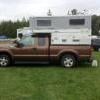So here's the question: Is the Zamp port on the outside of your camper hooked directly to the battery or is there a solar charge controller located between the Zamp port and the battery?
If there's a solar charge controller in the line between the exterior Zamp port and the battery, that's not necessarily a deal breaker but it may be an added complication that you might not want to deal with.
The other issue with the Zamp port is that the port connector (often referred to as an SAE connector) has its polarity wired backwards compared to what is common usage. The Zamp folks have their reasons for doing this but since some folks may not be aware of this, certain complications may arise.
If you are willing to spend some time learning about connector polarity and hooking a battery charger to a battery, possibly through a solar charge controller, I compliment you.
But if you are looking for simplicity, I would suggest this: Buy and install that Noco AC port or something similar. It never hurts to have ready access inside your camper to a 120V ac connection and the AC port is an easily-installed way to do that. Then, inside your camper, you can simply plug in your battery charger to that AC port and clamp the NOCO charger leads to your battery to keep it charged when you camper is not in use.
One other thing that isn't clear from your description is this: how do you keep your camper battery charged when you're using your camper? Do you have solar? Are you relying on the truck's charging system to charge your camper house battery? I ask that because if you have a solar system you probably are able to fully charge your battery when the solar panel is in sunlight. If that's so, then you may not need a plug-in charger when your camper is stored. If you pull the battery fuses so that there's absolutely no discharge, a fully charged battery can go for several months without losing enough charge to worry about.
On the other hand, if you're relying on your truck's charging system to charge your battery, the voltage drop caused by the long cable from your truck's engine compartment to your camper battery probably prevents the camper battery from ever becoming fully charged. In this situation, it might be better to fully charge the camper battery with your new Noco charger (either in or out of the camper) and then just let the battery sit disconnected for a few months.
One last point is that your Noco charger appears to be a 10 amp charger. This is a pretty hefty charger that would normally be used to recharge a battery that is significantly discharged. Your camper battery capacity is probably in the 80 amp-hour range. Hopefully, you're not discharging it more than 50% to extend its life which means that you need to replace no more than 40-50 amp-hours to fully top off your battery. Since your Noco charge is a 10 amp charger, that means it should be able to recharge those lost 50 amp-hours in approximately 5 hours.
Some people worry about keeping a battery charger connected to a fully-charged battery because of the danger of over charging. Your Noco charger probably does a good job of preventing over-charging but this is still something to keep in mind. In other words, a charger that is usually used merely to trickle-charge a battery during storage often has a rating of only 1 amp or even less.
All this is to say that you should go camping and have fun. But if you want to save a few hundred dollars in chargers and batteries over the years it's a good idea to read and study all the information you can find online about batteries, discharge, charging, etc.
Go have fun.
Ed
![]()

















